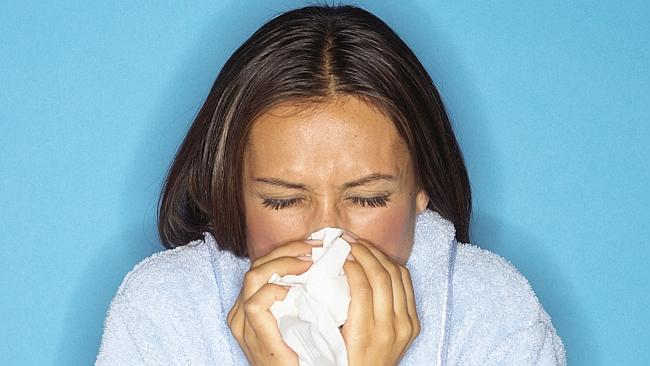
Dangerous virus … A deadly strain of flu that killed Americans in epidemic proportions is already in Australia. Picture: Supplied Source: Supplied
THE roll out of the flu vaccine will be delayed by more than a month this year, leaving vulnerable patients exposed to an H3N2 strain that has killed Americans in epidemic proportions.
The nation’s medicines watchdog said yesterday the influenza vaccination program would be delayed from the usual start date of 15 March until April 2015.
“The 2015 Program start date has been put back due to a double strain change from the 2014 influenza vaccine which has led to manufacturing delays,” the TGA said.
There have already been more than 2,401 cases of influenza notified in Australia, well above average for this time of year.

Rising sickness … The number of cases of influenza so far this year is above average. Picture: News Corp Source: News Limited
Queensland is experiencing the worst outbreak with nearly 500 cases in January.
The number of cases is likely to be even higher than this because these are only laboratory confirmed cases of the flu.
The H3N2 flu was the dominant strain in the United States this year, and a US Centre for Disease Control report shows deaths from influenza and pneumonia in 122 cities was above epidemic proportions, influenza expert Dr Alan Hampson said.

Epidemic … A US Centre for Disease Control report shows deaths from influenza and pneumonia in 122 cities was above epidemic proportions. Picture: Supplied Source: Supplied
Experts report that seasons when H3 viruses are predominant see more hospitalisation from flu and more deaths from the flu.
“I think you can be sure it is H3N2 virus in Australia,” he said.
There is also a major outbreak of Swine flu in India at the moment, he said.
US officials revealed in December the flu vaccination in that country was not protective against about half the H3N2 cases of flu circulating that season.
The World Health Organisation has also expressed “particular concern” about changes in the H3N2 seasonal influenza viruses, which have affected the protection conferred by the current vaccine”.
“As a result, interim estimates of the effectiveness of the current seasonal vaccine in reducing the risk of medical visits associated with influenza infection — in all age groups — was only 23 per cent in the US,” the WHO says.

Strong vaccine … Although the US flu vaccine did not protect against the strain of H3N2, Australia’s vaccine will. Picture: News Corp Australia Source: News Limited
However, Dr Hampson said Australia’s flu vaccine would protect against this killer strain.
‘”Our vaccine has been updated and will cover this strain,” he said.
The chair of the Australian Influenza Specialist Group Dr Alan Hampson said normally it was not until June that we saw a spike in cases.
And the late roll out of the vaccine would put pressure on doctors to get patients immunised before the outbreak occurred, he said.
Dr Hampson said the delays in producing this year’s vaccine were related to difficulties growing the flu strains in laboratories.
“They don’t often grow to the right level,” he said.
And the problem was compounded by the need to include two new strains of flu in the vaccine.
Australia’s Commonwealth Serum Laboratories produces flu vaccine locally but its vaccine cannot be used in children aged under five.

Held up … Australia’s flu vaccine has been delayed because of problems in manufacturing. Picture: Supplied Source: Supplied
Dr Hampson says the government has had to wait for overseas suppliers to ship in vaccines that can be used in young children and this has also delayed the roll out of the flu vaccines.
Free flu vaccine is available for the over 65s, Aboriginal and Torres Strait Islander people from 15 years of age, pregnant women, anyone aged six months and over with heart disease, severe asthma, chronic lung condition, chronic illness, diseases of the nervous system, impaired immunity, diabetes.
The flu is caused by a virus that spreads through the air by coughing, sneezing or talking, and by touching a person’s hands or surfaces touched by and infected person.
It infects the nose, throat and lungs and includes symptoms cold as symptoms such as fever, sore throat and muscle aches, it last about a week but can cause complications like pneumonia and bronchitis or death.
Originally published as Deadly virus hits Australia
